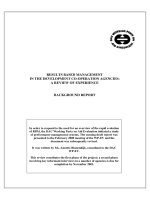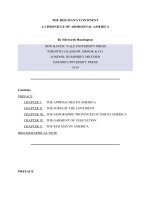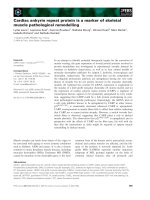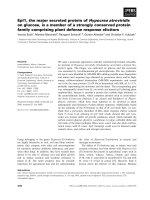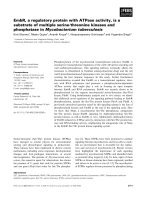The food you eat is a source of nutrients
Bạn đang xem bản rút gọn của tài liệu. Xem và tải ngay bản đầy đủ của tài liệu tại đây (723.43 KB, 33 trang )
1
©2002 Learning Zone Express
Louanne Kaupa, RD, LN.
Nutrients
The food you eat is a source of nutrients. Nutrients are defined as
the substances found in food that keep your body functioning.
Your body needs nutrients to…
2
Fuel your energy.
Help you grow.
Repair itself.
Maintain basic bodily functions.
©2002 Learning Zone Exp
Balance is Key
For y ears, people held to the idea that there are “bad”
nutrients and “good” nutrients w hen, in fact, all
nutrients play a certain role in the body . Ev en those
nutrients once considered “bad” such as fats and
carbohy drates perform v ital functions in the body and if
one consumes too many “good” nutrients such as
v itamins or minerals there can be harmful results, as
These
w ell.three are the framework of the Food Guide Pyramid:
Balance - Eat foods from all groups of the Food Guide Pyramid.
Variety - Eat different foods from each food group.
Moderation - Eat more foods from the bottom of the pyramid, and fewer
and smaller portions of foods from the top of the pyramid.
3
©2002 Learning Zone Exp
The 6 Essential Nutrients
4
Water
Carbohydrates
Protein
Fat
Vitamins
Minerals
©2002 Learning Zone Exp
Water
Did you know?
1/2 to 3/4 of the human body consists of water!
Functions in the Body:
Water carries nutrients to your cells and carries waste from
your body.
Regulates body temperature.
Dissolves vitamins, minerals, amino acids and other
nutrients.
Lubricates joints.
It is recommended that teens drink 6-8 glasses (8 fl.oz each) of water each day.
This is in addition to around 4 cups of water you get from food each day.
5
©2002 Learning Zone Exp
Carbohydrates
Carbohy drates are the body ’s main source of
energy and prov ide the body ’s need for
dietary fiber.
Food Sources:
6
Pasta, breads, cereals, grains, rice, fruits, milk, yogurt
and sweets.
Two types of Carbohydrates:
Starches or Complex Carbohydrates
Simple Carbohydrates
©2002 Learning Zone Exp
Simple Carbohydrates
Food Sources:
Fruits, juices, milk, and yogurt.
Candy, soda, and jelly.
•
7
These simple carbohydrates have a bad reputation because they
are high in calories and low in nutritional value.
©2002 Learning Zone Exp
Starches or
Complex Carbohydrates
Food Sources:
8
Whole grain breads and cereals,
pasta, vegetables, rice, tortilla
and legumes.
Function in the Body:
An excellent source of fuel (energy)
for the body.
Rich in vitamins, minerals and fiber.
©2002 Learning Zone Exp
Fiber
Fiber is the plant material that doesn’t
break down when you digest food. Many,
but not all, complex carbohydrates contain fiber.
Food Sources:
Function in the Body:
9
Oatmeal, fruits, vegetables, whole grains and legumes.
Aids in digestion.
May reduce the risk of developing some diseases like heart
disease, diabetes and obesity, and certain types of cancer.
Helps promote regularity.
©2002 Learning Zone Exp
Proteins
Food Sources:
10
Meat, fish,eggs, poultry, dairy products,
legumes, nuts and seeds. (Breads, cereals and vegetables also
contain small amounts of protein.)
Function in the Body:
Provides energy.
Help to build, maintain, and repair body tissues.
Proteins are made up of chemical compounds called
amino acids. There are 20 amino acids.
©2002 Learning Zone Exp
Amino Acids
Of the 20 amino acids, the human body
is capable of producing 11 of them.
The other 9 called, “Essential Amino Acids”
must be supplied by food sources.
Two types of Protein:
Complete Proteins:
•
•
Contain all 9 essential amino acids.
They are found in animal sources.
Incomplete Proteins:
Lack one or more of the essential amino acids.
• They are found in plant sources.
The best way to give the body complete proteins is to eat a wide
•
11
variety of foods throughout the day.
©2002 Learning Zone Exp
Fat
- The most concentrated form of food energy (calories).
Food Sources:
12
Butter, vegetable oils, salad dressings, nuts and
seeds, dairy products made with whole milk
or cream, and meats.
Function in the Body:
Provide substances needed for growth and healthy skin.
Enhance the taste and texture of food.
Required to carry “fat-soluble”
vitamins throughout the body.
Provide energy.
©2002 Learning Zone Exp
Types of Fat
Saturated Fat:
Fats that are usually solid at room temperature.
Food Sources: Animal foods and tropical oils.
The type of fat most strongly linked to high cholesterol and
increased risk of heart disease.
Unsaturated Fat:
Fats that are liquid at room temperature.
Polyunsaturated Fat:
•
•
Monounsaturated Fat:
•
13
Food Sources: Vegetables and fish oils.
Provide two essential fatty acids necessary for bodily functions.
•
Food Sources: Olive oil, canola oil, nuts, seeds.
May play a role in reducing the risk of heart disease.
©2002 Learning Zone Exp
Cholesterol
- A fat-like substance that is part of every cell of the body.
Function in the Body:
14
Helps the body make necessary cells including skin, and
hormones.
Aids in digestion.
The human body manufactures all the cholesterol it needs.
You also get cholesterol from animal food products you eat.
When cholesterol levels are high
there is a greater risk for heart disease.
Do you know what the healthy cholesterol
range is for teens your age?
©2002 Learning Zone Exp
Vitamins
Food Sources:
Unlike carbohydrates, fats, and proteins, vitamins DO
NOT provide energy (calories).
Function in the Body:
15
Fruits, vegetables, milk, whole-grain breads,
cereals and legumes.
Help regulate the many chemical processes in the body.
There are 13 different vitamins known to be required each
day for good health.
Vitamins are separated into two types: Fat Soluble & Water
Soluble Vitamins.
©2002 Learning Zone Exp
Fat/Water Soluble Vitamins
16
Fat Soluble Vitamins
Vitamins A, D, E, K
Require fat for the stomach to allow them to be carried into
the blood stream for use (absorption).
Can be stored in the body for later use.
Water Soluble Vitamins
Vitamins C and B-complex
Require water for absorption.
Easily absorbed and passed through the body as waste.
©2002 Learning Zone Exp
Vitamin A
Food Sources:
Function in the Body:
17
Dark green, leafy vegetables, deep yellow and orange fruits
and vegetables, liver, milk, cheese, and eggs.
Helps keep skin and hair healthy.
Aids in night vision.
Plays a role in developing
strong bones and teeth.
©2002 Learning Zone Exp
Vitamin D
18
Food Sources:
Vitamin D fortified milk, egg yolk, salmon,
and liver.
Nonfood Source: the sun.
Function in the Body:
Helps the body use calcium and phosphorus.
Plays a role in building strong bones
and teeth.
©2002 Learning Zone Exp
Vitamin E
Food Sources:
Function in the Body:
19
Whole-grain breads and cereals; dark green, leafy
vegetables; dry beans and peas; nuts and seeds; vegetable
oils; margarine; liver.
Helps form red blood cells, muscles, and other tissues.
©2002 Learning Zone Exp
Vitamin K
Food Sources:
Function in the Body:
20
Dark green and leafy vegetables (such as spinach, lettuce,
kale, collard greens), and cabbage.
Helps blood to clot.
©2002 Learning Zone Exp
Vitamin B-complex
Food Sources:
21
Whole grain and enriched breads and cereals; dry bean and
peas; peanut butter; nuts; meat; poultry; fish; eggs; milk.
Function in the Body:
Helps the body use the energy
from the foods we eat.
Helps brain, nerves, and
©2002 Learning Zone Exp
muscles function.
Vitamin C
Food Sources:
22
Citrus fruits, strawberries, kiwi,
broccoli, tomatoes, and potatoes.
Function in the Body:
Helps heal wounds.
Helps maintain healthy bones,
teeth, and blood vessels.
Helps body fight infection.
©2002 Learning Zone Exp
Minerals
Food Sources:
23
Meats, beans, nuts, fruits, vegetables, dairy products, and
grains.
Functions in the Body:
The body depends on minerals for practically every process
necessary for life.
Minerals actually become part of the body.
The body requires 16 minerals daily.
©2002 Learning Zone Exp
Minerals
Calcium
Phosphorus
Magnesium
Sodium
Potassium
Iron
Others include:
24
Iodine, Zinc, Copper, Sulfur, Chloride, etc.
©2002 Learning Zone Exp
Calcium & Phosphorus
Food Sources:
Function in the Body:
25
Dairy Products: milk, cheese, ice cream, green leafy
vegetables, canned sardines and other processed fish eaten
with bones.
Helps build and maintain healthy bones and teeth.
Helps heart, nerves, and muscles work properly.
Deficiency (lack) of calcium & phosphorus leads to osteoporosis.
©2002 Learning Zone Exp




